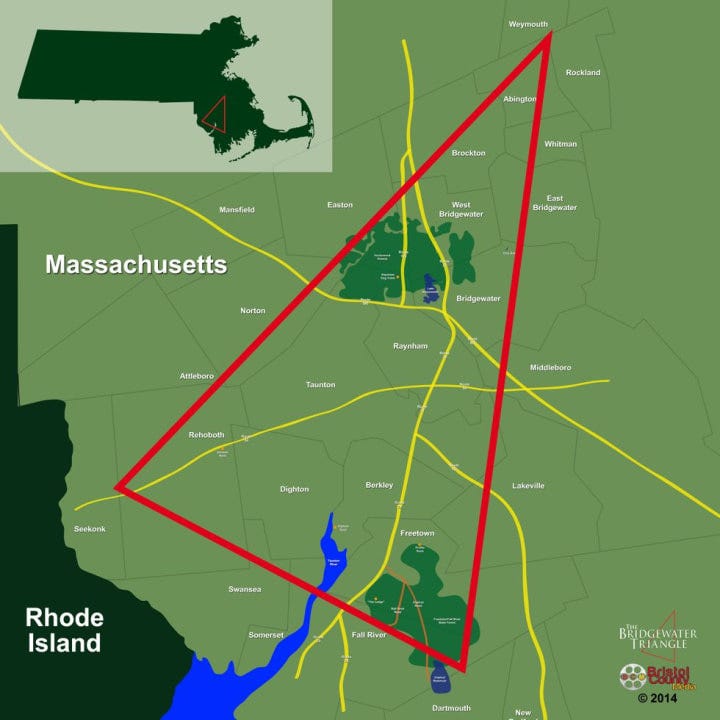Foggy Waters of The Bridgewater Triangle
The Hockomock Swamp

In Massachusetts, there are three Bridgewater’s, East, West and Bridgewater; together, along with the City of Brockton, they were once an entity known as North Bridgewater.
- I lived and grew up in West Bridgewater matriculating and graduating from the West Bridgewater High School in 1965.
- In the late 1950’s, as a kid, my brother and I did lots of exploring in our town, often in the wet and swampy area known as the Hockomock Swamp. We never volunteered to Mama, where we had been. She morbidly feared one of us drowning, why, I don’t know. If she asked why we were wet, we’d say we were down at West Meadow, where there was a little brook. We would take our dog, Missy, and she’d be wet and filthy. Mama breathed easier, knowing it was just a meadow.
- Actually, we had been a few miles from home and at the west end of the town, where it was swampy and at times, tough to navigate without a large stick, a hockey stick with the business end broken off, would have been perfect. The stick was good for pushing against something solid to pull up a wet sneaker, with your foot still in it. My brother lost a sneaker on one expedition, in the muckiest stuff we ever saw. It was a swamp, yet there were paths, and clearings where you could enjoy some dry turf to sit and feel the warmth of the sun. In school, we had learned that the Wampanoag Indians used this area to get around the Nunckatessett River, which we only knew as the Town River.
- I only remember that it was wet, it smelled awful, and it was eerily quiet. There were millions of mosquitos and as a shadowy mist hovered over these foggy waters, it took on an damp and uneasy feeling, like slime was trying to consume you. After a few hours of exploring, my thoughts always went toward finding the shortest distance to get out of there. The aim, originally, was to find where the river and the swamp came together, but it was confusing and I ended up thinking it was like the Mississippi Delta, touching in many places along the way. Finding your way out, always brought a rush of positive vibes, fresh air, a new way to enter the swamp and a desire to go eat, usually Hostess Cupcakes or Snoballs and a nice cold bottle of Pepsi from the Hockomock store.
*****
- Fast forward about 50 years, and an article I spotted in the Fort Myers News-Press, an article with the headline “ Hockomock Swamp: Center of The Bridgewater Triangle”. Say what !!!!

- I looked to see if it was the same place I was brought up and lived most of my young life, and it was. The article asked this question: What lies beneath Hockomock Swamp? Other than my brother’s sneaker, I had no idea.

- It seems that Loren Coleman, a noted cryptozoologist (a person that searches for and studies animals whose existence is disputed or unsubstantiated, like the Loch Ness monster or Big Foot), had written a book, Mysterious America. In the book, he reveals an area of about 200 square miles claimed to be a site of alleged paranormal phenomena, ranging from UFO’s to poltergeists, orbs, balls of fire and other spectral observations, including various bigfoot-like sightings, giant snakes and thunderbirds. I didn’t know that!
- Who knew that growing up in eastern Massachusetts, we were close to one of the world’s known capitals of strange occurrences? (Quiet peanut gallery) Together, the towns of Abington, Freetown, and Rehoboth form the 200 square-mile triangular area where tons of paranormal activity constantly happen, per (Paranormal-Encyclopedia).
- A map of The Bridgewater Triangle places my home town and the Hockomock Swamp just about in the center, so I researched and found several interesting references close to where I roamed with my friends in the 1950’s.
- To get closer to the facts, we need to first understand that before settlers arrived in New England, The Wampanoag Indians were the rulers of most of New England stretching to Connecticut and far north to Maine. The first direct contact with a Native American was made in March 1621, and soon after, Wampanoag Chief Massasoit paid a visit to the settlement, in Plymouth. After an exchange of greetings and gifts, the two peoples signed a peace treaty that lasted for more than 50 years.
- Fifty years of peace. It was only a matter of time, right?
- Massasoit dies, his oldest son, Wamsutta, takes over as chief only to die a short time later. The next in line, was Metacomet, also known as King Philip, a name taken to honor the settlers. King Philip disapproved of the ever-growing number of settlers draining the swamps to expand their farms, especially swamps that the Wampanoag held as sacred places.

- In 1675, war broke out as the last attempt of some Native American tribes to drive the English settlers out of New England. This war was known as King Philip’s War, various tribes joined to battle the settlers. This ended with Metacomet/King Philip being kidnapped and beheaded. The settlers had won the fourteen-month long war (History.com). Much of this war took place in Hockomock Swamp, for the Wampanoag’s it was a great area to use for strategy, sadly, it did not help them enough to win the war.
- Hockomock Swamp wasn’t just creepy to people back in the day, it remains pretty ominous to this day. Many that visit the swamp today, claim to see apparitions of Native Americans “ghost dancing”. Interviewing a resident of the triangle, the following quote “’The neighborhood kids often talked about feeling watched in the swamp”. It’s said some can hear something bulling through the forest, knocking down trees; others have heard bloodcurdling screams.
- I can only add that somewhere, probably below the swamp is a left PF Flyer sneaker.

- Historical Notes:
1. Hockomock Swamp, known as the heart of the triangle, is 16,950 acres in total. Before Native Americans were widely killed off, they had respected the swamp, thinking of it as magical and sacred. However, it being very mysterious, was named “Hockomock” which means “place where spirits dwell”. To the English settlers, it was known as “Devil’s Swamp”.
2. Solitude Stone — An inscribed stone located near Forest Street in West Bridgewater which was found near a missing person’s body. Also known as “suicide stone,” the rock was found with the inscription: “All ye, who in future days, Walk by Nunckatessett stream Love not him who hummed his lay Cheerful to the parting beam, But the beauty that he wooed.”

- Theories:
1. It is theorized that the anger and negative energy from the King Philip’s War was trapped in the swamp and in the surrounding areas, causing paranormal activity to occur here even to this day (WCVB). “There are many reasons for the presence of paranormal activity in the area, with many locals claiming the cause to be Native American curses. After the colonists settled the area in the 17th and 18th centuries, the Native American peoples were treated poorly and the “wampum belt” of the Wampanoag people was lost during subsequent battles. This lost belt has allegedly caused significant paranormal unrest amongst the ghost warriors that haunt the Bridgewater Triangle to this day.” (Roadtrippers)
2. Because of the magnetic field and force of gravity in some areas of the world, strange things happen. No one really knows why and there isn’t enough solid proof as to what things happen or can be seen, but it said that reality may be bent in these areas or that we are able to see through to other dimensions in vortexes like The Bridgewater Triangle. ‘’’Throughout the world, there are areas that have vortexes, or windows, in which the laws of gravity seem not to operate in the way as understood in the natural world,” says Pittman, who lives in Franklin. ‘’And while not all these places are rife with the paranormal, I am fairly confident that almost any place you find the paranormal humming, there is also a vortex where gravity and energy aren’t behaving normally.’” (Boston.com)













No comments:
Post a Comment